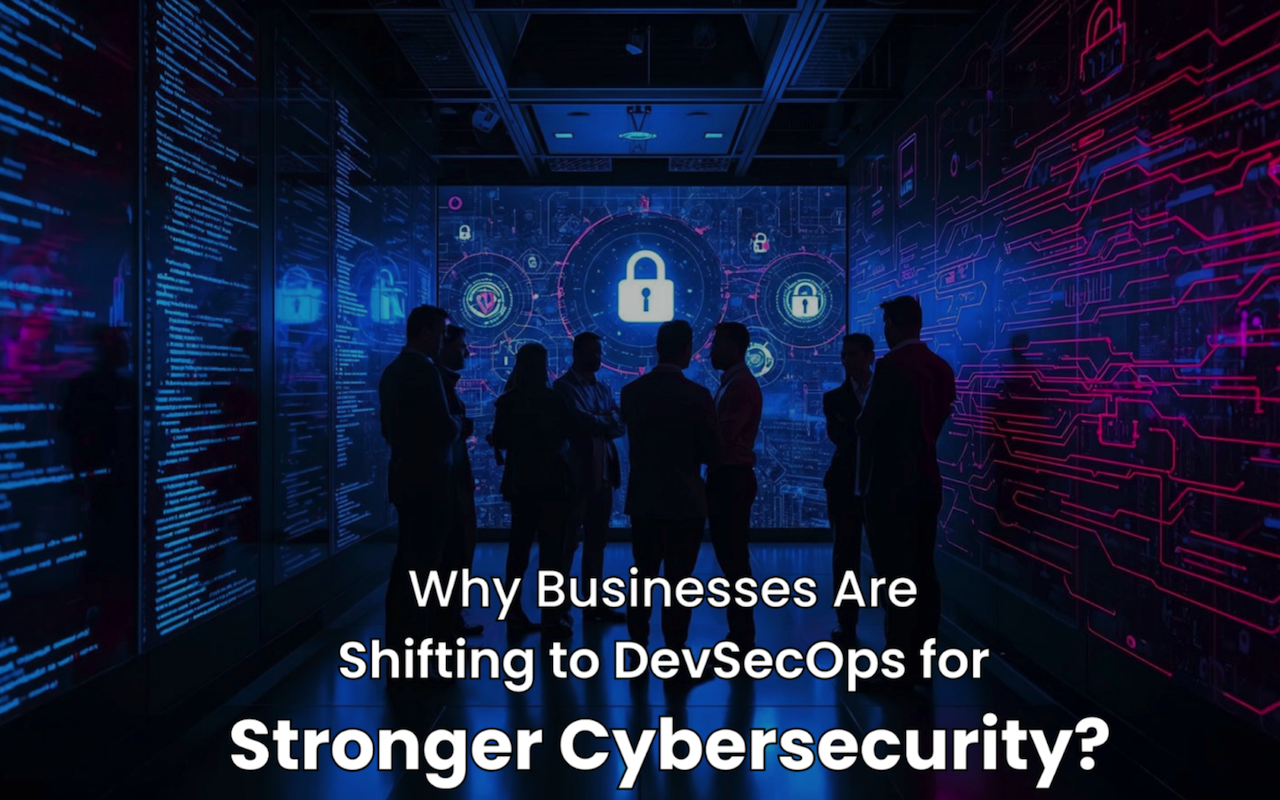
As modern-day attackers grow more technologically sophisticated, cybersecurity has become a core business imperative. Leaders across industries are now asking a critical question: how can software be protected from the very beginning of the development process?
To answer this, many organizations are adopting DevSecOps, a security-first approach, that blends development, security, and operations into one unified, automated workflow. This modern framework integrates security controls early and continuously, preventing vulnerabilities before attackers can exploit them. For organizations, this translates into safer digital transformation, improved customer trust, and stronger performance and ROI.
In this article, we will walk through the DevSecOps methodology and explore how teams can implement it effectively to strengthen their security posture.
Understanding the DevSecOps Concept
DevSecOps is a methodology that embeds security into every phase of the software development lifecycle (SDLC). Instead of performing security checks only at the end, DevSecOps automates and integrates them directly into the CI/CD pipeline. This ensures that development, security, and operations teams work together seamlessly toward a shared mission: delivering secure, high-performing applications—quickly and consistently.
In simple terms, DevSecOps accelerates innovation while maintaining strong, continuous security. Below is an overview of how DevSecOps reinforces protection at every step of the CI/CD pipeline.
Coding
Coding forms the foundation of software development. At this stage, DevSecOps encourages:
- SAST (Static Application Security Testing) to scan code in real time for vulnerabilities.
- Secrets scanning to prevent credentials, tokens, and keys from being committed to repositories.
- Signed commits so that code changes can be traced back to verified developers.
These practices help stop insecure code and exposed secrets from ever entering the main branch.
Building
During the build stage, the source code is compiled into deployable artifacts. DevSecOps introduces controls such as:
- SCA (Software Composition Analysis) to inspect open-source components and libraries for known vulnerabilities.
- Container image scanning to identify malware, misconfigurations, and outdated packages in images.
- Image signing to ensure only trusted, approved builds are allowed to move further down the pipeline.
This ensures that both proprietary and third-party components meet security standards before progressing.
Testing
Testing is a critical stage in the SDLC, and DevSecOps extends it with security-focused checks:
- DAST (Dynamic Application Security Testing) to simulate real-world attacks against a running application.
- API security testing to prevent unauthorized access, broken authentication, or insecure endpoints.
These tests validate how the application behaves under real conditions, identifying weaknesses that static testing might miss.
Deploying
Deployment involves releasing applications into staging or production environments. DevSecOps supports this phase with:
- IaC (Infrastructure-as-Code) scanning to review Terraform, CloudFormation, or similar scripts for misconfigurations.
- Policy enforcement that blocks deployments not aligned with security or compliance baselines.
This reduces the risk of exposing systems due to insecure infrastructure definitions or rushed configuration changes.
Runtime
Once applications are live, DevSecOps continues to provide protection in runtime environments:
- Using a Web Application Firewall (WAF) to block malicious requests and common attack patterns.
- Container runtime security to monitor behavior, detect anomalies, and prevent unauthorized changes.
- Continuous security and compliance monitoring to detect drift from approved configurations.
This ongoing visibility ensures that security is not a one-time gate, but a continuous process.
Altogether, this end-to-end pipeline detects and prevents cyber threats before they cause damage—protecting performance, availability, and user trust.
Core Pillars of a Successful DevSecOps Strategy
Organizations can prevent software program vulnerabilities from being exposed to attackers by leveraging DevSecOps consulting. Below are the key pillars that enable a resilient, mature DevSecOps environment.
| Key Components | Description |
|---|---|
| Leadership & Automation | Leadership commitment to security-as-default, backed by automation. This includes integrating security tools (SAST, SCA, DAST, IaC scanning, etc.) into DevSecOps workflows to enable automated scanning, code reviews, and risk checks. The result is faster and more secure app development with real-time visibility across the SDLC. |
| Security-as-Code (SaC) | Security policies, guardrails, and infrastructure definitions are written and managed as code, then enforced in CI/CD pipelines. This helps target misconfigurations early, predict security posture, and identify high-risk factors before production. |
| 24/7 Threat Detection | Leveraging platforms like SIEM and XDR to monitor applications and infrastructure continuously. This enables teams to detect, investigate, and respond to attacks in real time, reducing downtime, protecting customer data, and avoiding regulatory penalties. |
| Zero-Trust & Least Privilege | Applying strict identity and access management practices, where no user, service, or component is trusted by default. Permissions follow the least-privilege principle, strengthening compliance and closing unnecessary exposure paths. |
| Shared Responsibility | Development, security, and operations teams share ownership of security outcomes. Joint KPIs, shared dashboards, and aligned workflows promote proactive security and long-term resilience against cyberattacks. |
Best Practices for Implementing DevSecOps
Once the pillars are in place, organizations should focus on practical steps that make DevSecOps sustainable and impactful in everyday work.
Shift Left
“Shifting left” is a core DevSecOps principle. It means moving security checks earlier in the SDLC—from right (production) to left (development). The goal is to ensure each component is well-patched, securely configured, and documented before it reaches later stages.
In practice, this includes introducing early SAST, secrets scanning, and dependency checks. Addressing issues at this stage reduces the cost of fixes and shortens the time to market, while significantly lowering the risk of critical bugs reaching production.
Automate Security in the CI/CD Pipeline
Automation is the backbone of DevSecOps. Teams should integrate security tools directly into CI/CD workflows so checks are triggered automatically with every commit, merge, or deployment.
Examples include:
- SCA to analyze dependencies during builds.
- IaC validation to prevent insecure infrastructure changes.
- Automated policy enforcement that blocks non-compliant builds or deployments.
This allows teams to balance speed and security without adding manual bottlenecks.
Establish a Collaborative Cybersecurity Culture
Tools alone are not enough. DevSecOps requires a culture where teams are open to change and share responsibility for security. Resistance often comes when security is seen as “someone else’s job” or as an obstacle to delivery.
To prevent this, development, security, and operations teams should:
- Align on common goals and KPIs.
- Hold joint retrospectives focused on security improvements.
- Share visibility through unified dashboards and incident reports.
This collaborative approach improves threat readiness and unifies workflows across teams.
Continuous Security Training and Awareness
Even the best tools can’t compensate for a lack of security awareness. Ongoing education helps developers write secure code and recognize risky patterns before they become production issues.
Organizations can:
- Offer secure coding training and labs.
- Run internal “capture the flag” or red team/blue team exercises.
- Provide just-in-time guidance through IDE plugins and code review checklists.
This leads to fewer bugs, better code quality, and greater resilience across the SDLC.
3 Key Benefits of DevSecOps for Businesses
When DevSecOps is treated as a core discipline rather than a one-off initiative, organizations can unlock significant strategic and operational benefits.
1. Adaptive and Automation-Enabled Process
DevSecOps thrives on automation. Security checks run continuously and adapt as systems evolve. Automated threat detection, risk assessment, and vulnerability scanning reduce manual toil and free teams to focus on higher-value work.
The real differentiator is not just using AI or automation, but applying them intelligently to minimize downtime, safeguard customer data, and strengthen the overall return on investment (ROI) of software initiatives.
2. Stronger CI/CD Pipeline Security
DevSecOps hardens the CI/CD pipeline itself—a common target for attackers. By embedding security gates, validating artifacts, and enforcing policies at each stage, organizations:
- Reduce the risk of malicious code or misconfigurations entering production.
- Lower the need for manual reviews and emergency hotfixes.
- Eliminate “shadow IT” behaviors by making secure practices the default.
The result is a pipeline that is not only fast, but also trustworthy.
3. Support for Cloud-Native Architectures
As organizations move toward microservices, containers, and multi-cloud environments, DevSecOps becomes even more critical. It supports cloud-native architectures by:
- Enforcing identity and access controls across services.
- Applying runtime microsegmentation to limit lateral movement.
- Improving end-to-end visibility across clusters, environments, and regions.
This ensures that performance, scalability, and security evolve together rather than in isolation.
Final Thoughts
DevSecOps is an evolution of DevOps that places security at the forefront of modern software development. Instead of treating security as a final checkpoint, it turns it into a continuous, collaborative, and automated practice woven into every phase of the SDLC.
This approach is proactive by design. It helps organizations catch vulnerabilities early, respond to threats faster, and turn security from a bottleneck into a competitive advantage.
For leaders looking to modernize their development practices, DevSecOps offers a clear path toward secure, scalable, and resilient digital growth—where speed and security finally move in lockstep.
Share this post
Leave a comment
All comments are moderated. Spammy and bot submitted comments are deleted. Please submit the comments that are helpful to others, and we'll approve your comments. A comment that includes outbound link will only be approved if the content is relevant to the topic, and has some value to our readers.


Comments (0)
No comment